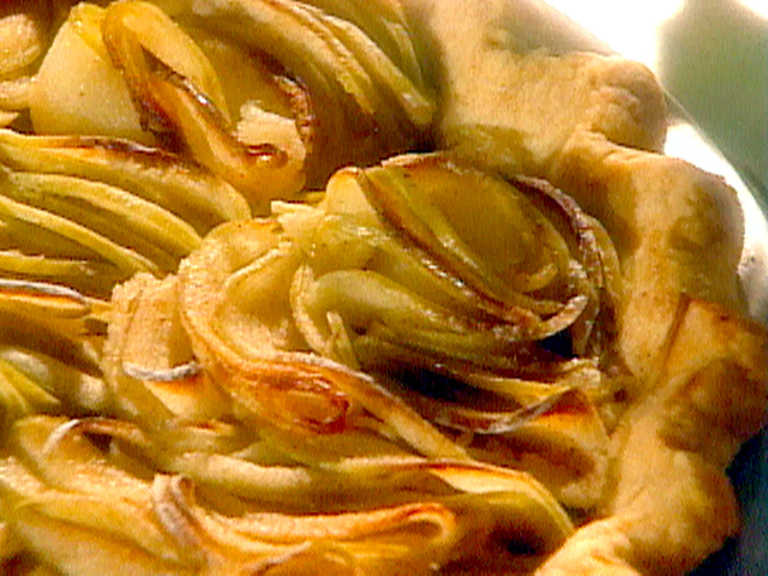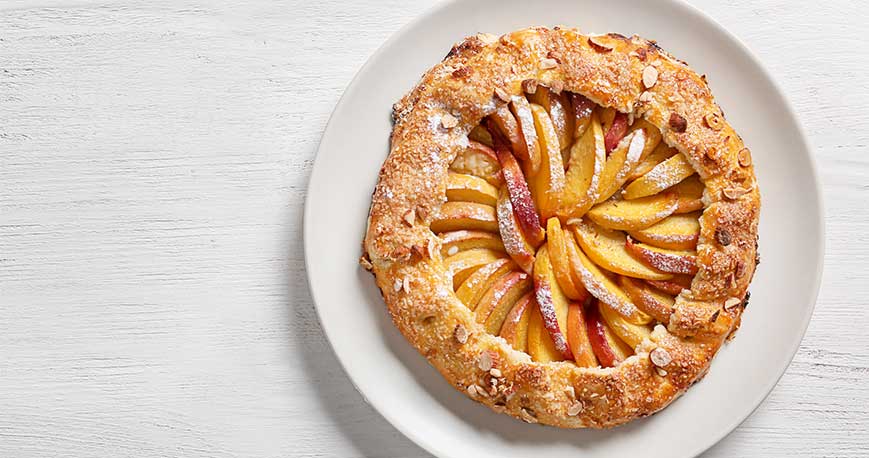Apple Ribbon Pie
- 2 1/4 cups sifted all-purpose flour
- 1 teaspoon salt
- 1 teaspoon sugar
- 6 ounces cold unsalted butter, cut into pieces
- 1/4 cup ice water (strain out the ice just before using)
- 1 teaspoon red wine vinegar
Make the Crust: In a mixer fitted with a paddle attachment (or using a hand mixer), mix the flour, salt, and sugar for 1 minute. Add the butter and mix just until you have a crumbly, sandy mixture. (You should still be able to see the pieces of butter.)
In a small bowl, stir the water and vinegar together.
With the mixer running at medium speed, drizzle in the water-vinegar mixture and mix just until a dough forms. (You should still see small bits of butter.) Transfer the dough to a work surface and shape into a round, flat disk. Wrap in plastic wrap and refrigerate at least 30 minutes before using. (Or, refrigerate up to 48 hours or freeze up to 1 month before using. If frozen, let thaw in the refrigerator overnight before rolling out.)
When the time comes to roll out the dough, let the dough warm up for a few minutes at room temperature to make it more workable. Dust a work surface with just a few tablespoons of flour and keep some extra flour at hand. Sprinkle a little flour on top of the dough and start rolling outward from the center with quick, light strokes. Don't worry if the edges split a bit; concentrate on forming a good circle from the center. Lift up and rotate the dough 1/4 turn every minute or so to help ensure even rolling. The dough should feel smooth and soft; some say it should feel like the inside of your forearm. If it gets sticky, sprinkle on a bit more flour, but don't do this more than 2 or 3 times; the dough will absorb too much flour. Instead, put it back in the refrigerator for 15 minutes to firm up the butter. Keep rolling until the circle is at least 2 inches larger than your pan (for example, 12 inches wide for a 10-inch pie pan), or 3 inches larger for deep-dish pies.
Set your pie pan nearby. We always use heavy aluminum pans, because glass pans seem to bake the crust too fast. However, we know that the advantage of glass is that you can easily check the color of the crust. To transfer the crust to the pan, I find it easiest to roll a finished crust up onto the rolling pin, then gently unroll it in the pan. Or, you can fold it gently in quarters, lift it up, position the center point on the center of the pan, and unfold it into the pan. Make sure that the dough is allowed to settle completely into the pan.
Don't stretch and press the dough into the corners; stretched dough will likely shrink back when you bake it. Instead, lift the edges of the crust to let it settle down into the corners. If the dough tears a bit, don't be concerned; we'll patch it in a minute. Using scissors or a sharp knife, trim the dough to within 3/4-inch of the rim. Use any extra scraps to patch the crust, pressing with your fingers (wet them if necessary) or set aside. To decorate the rim, fold under the excess dough then just press it all around with the back of a fork. For a slightly more advanced look, press the thumb and forefinger of one hand together. Use them to gently push the thick dough rim outward, while pushing inward with the forefinger of the other hand, so that they intersect in a "V" with the dough in between. Repeat all around the rim to make a wavy edge. Chill it while you prep the filling.
Make the Filling: Preheat the oven to 425 degrees F.
In a medium bowl, toss the sugar, salt, cornstarch, cinnamon, and nutmeg together. Sprinkle half the sugar mixture on the bottom of the pie shell.
Using a Japanese-style turning vegetable slicer, cut the apples into 1-inch wide, long strips. Make apple strips into S-curves (like ribbon candy) and tuck them into the crust next to each other tightly to fill the pie shell. Sprinkle the remaining sugar mixture over the ribbons and dot with the butter.


